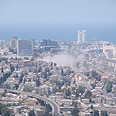
Northern shelters improve, but not in non-Jewish sector
Defense Ministry and local authorities can boast wide range renovations to public shelters since 2nd Lebanon War. In non-Jewish sector conditions are far from satisfactory. In Nazareth, for instance, only quarter of residents will have shelter during war
Seven months after the war Ynet published a survey of on the shelters' condition in local authorities. The examination revealed that despite promises for a quick aftercare, many of the public shelters remained in a disgraceful condition. Currently, three years after the war, things appear completely different – at least as far as public shelters go. In recent years the Defense Ministry has made an enormous investment with the help of outside elements headed by the 'Friendship Foundation', for the renovation of thousands of shelters across the country, from the northern border front to the south. The renovations included paving, creating new foundations for water, electricity, cables and phones, as well as air conditioning and lighting installations. Some of the councils directed special personnel for the daily maintenance of the shelters.
A source in the home front command explained, "The wide range overhaul was made in the northern front communities, where the shelters were made suitable for extended stay. As one moves south of the border the level of renovation changes accordingly, with the assumption that a less extended stay is required. One can currently determine that approximately 85% of public shelters are of a good adequacy level. The trick is to sustain it over time and deal with vandalism".
Non Jewish sector suffers
The improvement in home front readiness, he explains, is incomparable to the way it was during the war. "It's not even on the same level. The public shelters' condition is only one variable in the story. In addition, the sirens array was upgraded, the councils practice on a regular basis, and readiness level is currently very good – surely in comparison to what was on hand three years ago", he stated.
Only the problem resurfaces when one looks to the non-Jewish sector. In northern Arab councils there is an acute shortage of shelters at the public's hand, since most of the apartments and residences were built before the restrictive norm requiring the construction of protected spaces in apartments.
The city of Nazareth was hurt badly during the war when two of its residents were killed in a Katyusha rocket attack on the city. Unlike other northern cities, where public shelters were available to residents despite their poorly neglected condition, Nazareth was left without any means of protection. Excluding two public shelters in the city and a small number of school shelters, the Nazareth residents had nowhere to hide themselves from the Katyusha rockets.
The State Comptroller's office, after having investigated the home front's alignment and function in the Second Lebanon War and submitted its report, directed the government to devise an assigned program to deal with the sheltering gaps in the non-Jewish sector and to make planning and budgeted decisions to close the gaps.
But as far as public protection goes, no progress has been made. Nazareth city general manager, Raji Mansour said "we have improved the level of coordination between emergency elements and have installed a loudspeaker system heard throughout the city. But as far as shelters go everything is as it was three years ago. One third of Nazareth houses were built in recent years and according to the norm. All the previously built ones are without protected spaces".
According to a home front command source, most of the public shelters were built in the 1950s and 60s, and in those years decision makers assumed the threat on the hinterland is not the main one. "The assumption was that the threat on Arab communities in the home front is even smaller" he said.
The source added, "even in the Jewish sector not every school holds a shelter. In Tel Aviv for example the residents-shelters ratio is even smaller".
The same source claims the solution is not in building new public shelters. "Since 1992 no one builds shelters, even in Jewish communities. The goal is to maximize the resources these councils have – insist that every building extension be subject to the creation of a protected space, and guide and train the population to adhere to directions – hide in protected spaces and lie on the floor," he explained.










